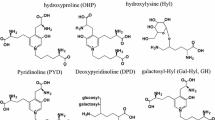Summary
β-1-galactosyl-0-hydroxylysine (GH) was measured in the urine of 59 women and 48 men, aged 30–79 years, by High Performance Liquid Chromatography (HPLC) of the dansylated derivative. Vertebral mineral density, measured by quantitative computed tomography (QCT), and urinary GH were inversely correlated (r=−0.74;P<0.001). High rate of bone mineral loss is associated with a high urinary GH excretion. Measurement of GH in urine provides a simple and noninvasive method for the evaluation of the extent of bone resorption in large groups of subjects and appears to be more specific than urinary hydroxyproline excretion.
Similar content being viewed by others
References
Cohn SH (1981) Noninvasive measurements of bone mass and their clinical application. CRC Press Inc, Boca Raton, Florida
Weiss PH, Klein L (1969) The quantitative relationship of urinary peptide hydroxyproline excretion to collagen degradation. J Clin Invest 48:1–10
Mundy GR, Raisz LG (1981) Disorders of bone resorption. In: Bronner F, Coburn JW (eds) Disorders of mineral metabolism, vol 3. Academic Press, New York, p 2
Segrest JP (1982) Urinary metabolites of collagen. Methods Enzymol 82:398–410
Segrest JP, Cunningham LW (1970) Variations in the human urinary 0-hydroxylysyl glycoside and their relationship to collagen metabolism. J Clin Invest 49:1497–1509
Moro L, Modricky C, Stagni N, Vittur F, de Bernard B (1984) High performance liquid chromatographic analysis of urinary hydroxylysyl glucosides as indicators of collagen turnover. Analyst 109:1621–1622
Askenasi R (1976) The estimation of collagen hydroxylysyl glycosides. In: Hall DA (eds) The methodology of connective tissue research. Joynson-Bruvvers Ltd, Oxford, p 263
Hyldstrup L, McNair P, Jensen GF, Nielsen HR, Transbol I (1984) Bone mass as referent for urinary hydroxyproline excretion: age and sex-related changes in 125 normal subjects and in those with primary hyperparathyroidism. Calcif Tissue Int 36:639–644
Kivirikko KI, Laitinen OI, Prockop DJ (1967) Modifications of a specific assay for hydroxyproline in urine. Analyt Biochem 19:249–255
Genant HK, Cann CE, Ettinger B, Gordan GS (1982) Quantitative computed tomography of vertebral spongiosa: a sensitive method for detecting early bone loss after oophorectomy. Ann Intern Med 97:699–705
Genant HK, Cann CE (1982) Quantitative computed tomography for assessing vertebral bone mineral. In: Genant HK, Chafetz N, Helms CH (eds) Computed tomography of the lumbar spine. Univ. Calif. Print Dpt. San Francisco, p 289
Cann CE (1981) Low-dose CT scanning for quantitative spinal mineral analysis. Radiology 140:813–815
Cann GE, Genant HK, Kolb FO, Ettinger B (1985) Quantitative computed tomography for prediction of vertebral fracture risk. Bone 6:1–7
Deacon AC, Hesp R, Hulm P, Green JR, Rinsler MG, Reeve J (1986) The estimation of rates of bone resorption from urinary hydroxyproline excretion in patients on simulated home diets. 19th Eur Symp Calcif Tissues (suppl) 39:A68
Krane SM, Kantrowitz FG, Byrne M, Rinnell SR, Singer SR (1977) Urinary excretion of hydroxylysine and its glycosides as an index of collagen degradation. J Clin Invest 59:819–827
Author information
Authors and Affiliations
Rights and permissions
About this article
Cite this article
Moro, L., Mucelli, R.S.P., Gazzarrini, C. et al. Urinary β-1-galactosyl-0-hydroxylysine (GH) as a marker of collagen turnover of bone. Calcif Tissue Int 42, 87–90 (1988). https://doi.org/10.1007/BF02556339
Received:
Revised:
Issue Date:
DOI: https://doi.org/10.1007/BF02556339




